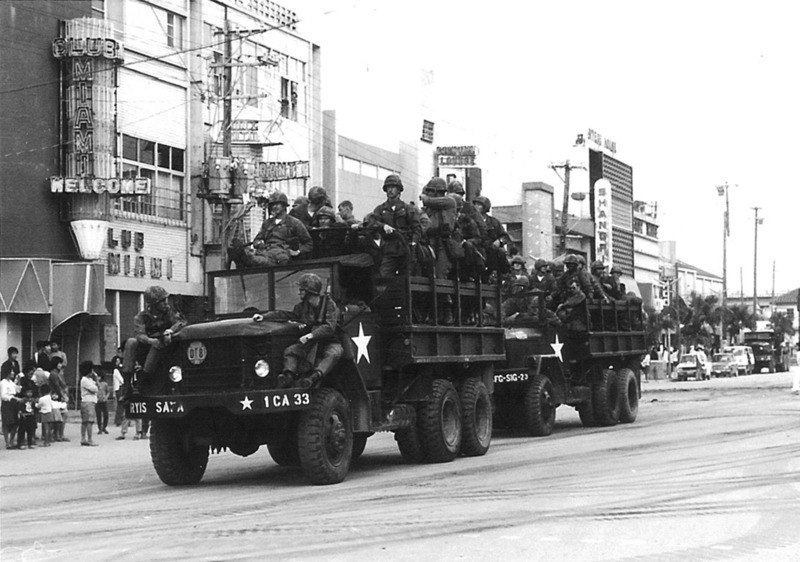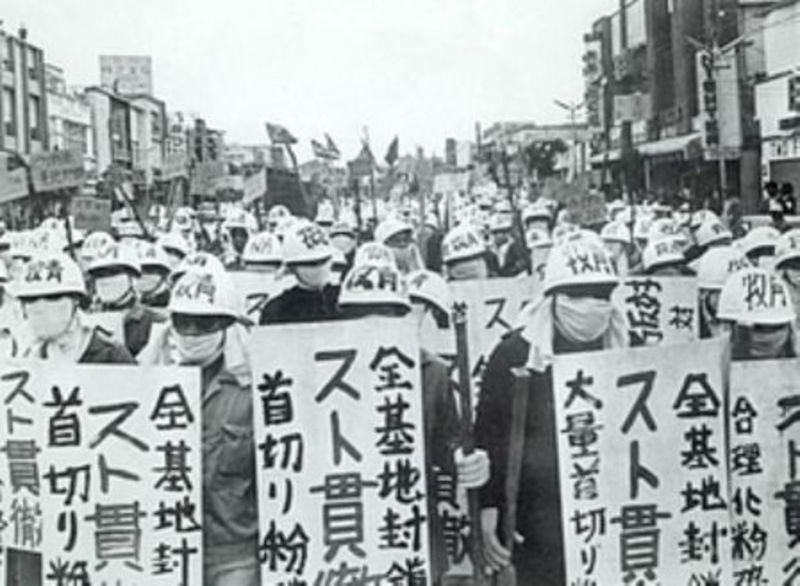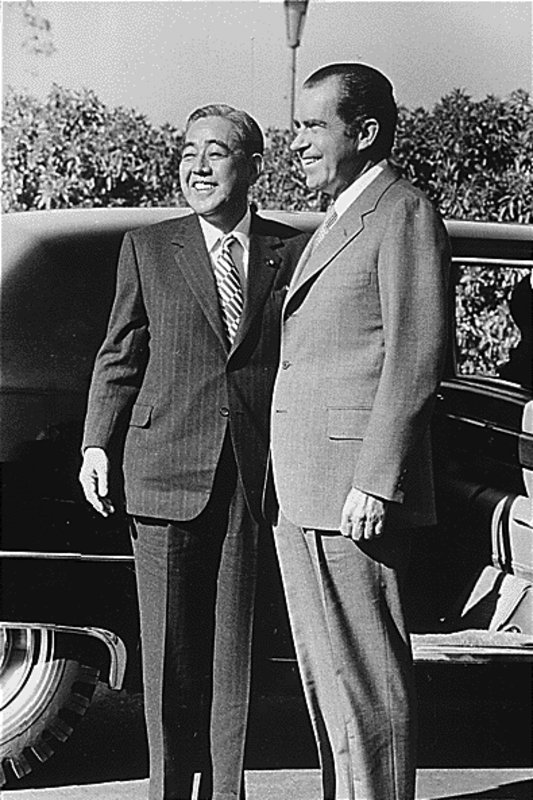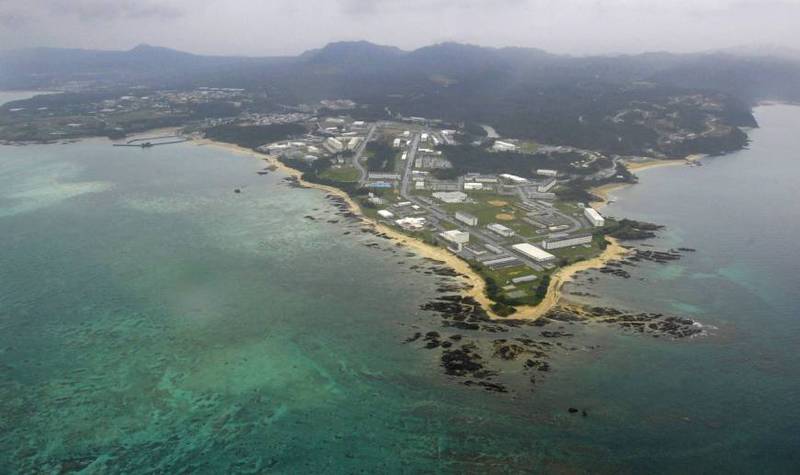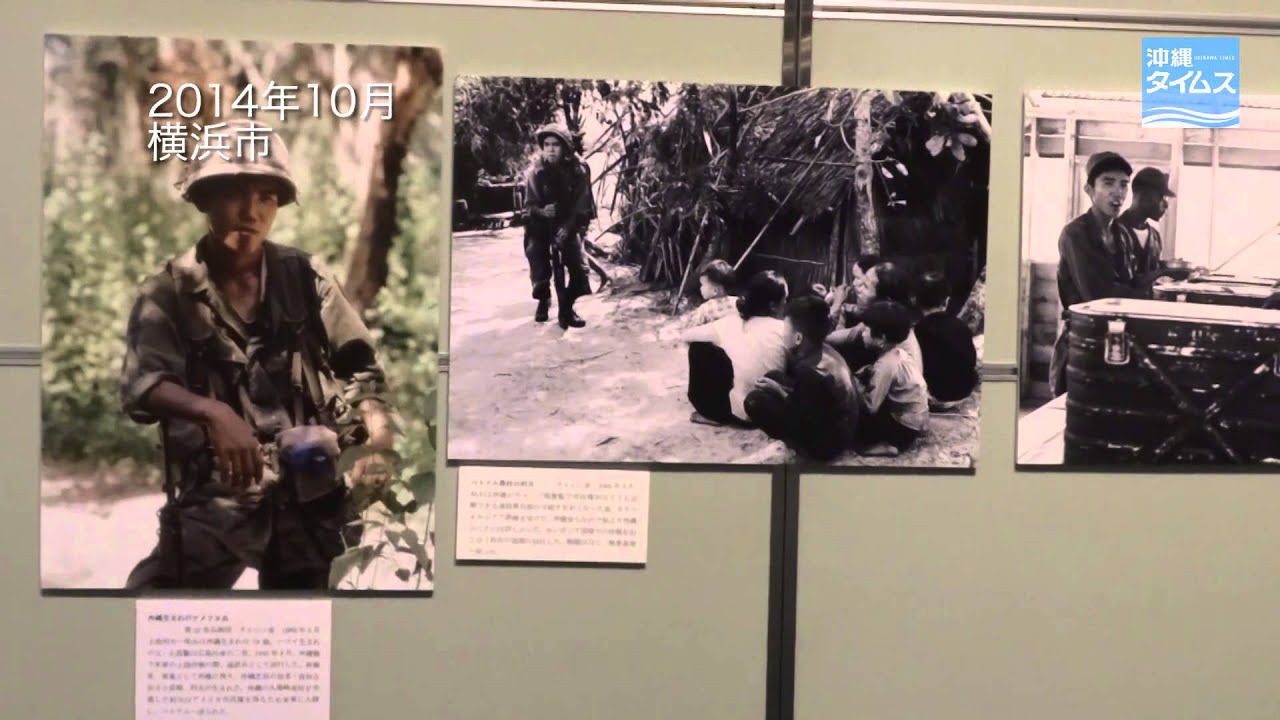 |
 |
| Evacuation of CIA personnel, Saigon, 29 April 1975. | North Vietnamese tank entering Presidential Palace, Saigon, 30 April 1975. |
On 30 April 1975, North Vietnamese troops and their supporters entered Saigon.
Their arrival ended three decades of conflict – including 10 years of direct U.S. intervention – which left as many as 3 million dead and countless others suffering from the legacy of PTSD, unexploded ordnance and Agent Orange.1
As the world remembers this 40th anniversary, all too often forgotten is the role of the Pentagon’s most important launch-pad for this failed war: Okinawa.
The Vietnam War wrought massive changes on the lives of the island’s 900,000 residents. Many of Okinawa’s current problems date back to this era and, if the history of the Vietnam War there continues to be ignored, the island’s wounds – in many ways as raw as those in southeast Asia and the U.S. – will continue to fester long into the future.
* * *
Between 1945 and 1972, Okinawa was under American governance or, as former U.S. ambassador to Tokyo, Edwin O. Reischauer, stated in 1969, the island was “a colony of one million Japanese.”2 Few U.S. officials – then or since – have referred so bluntly to the island’s geopolitical status, however his assessment was entirely accurate. On Okinawa, the U.S. authorities kept tight control on the media, they denied passports to those deemed critical of Washington and Okinawans had no power to elect the person who governed them – the U.S. High Commissioner.3
With the island protected by neither the constitutions of the U.S. or Japan, the Pentagon exploited this limbo by transforming Okinawa into its Keystone of the Pacific. Throughout the 1950s and ’60s, it stockpiled an unprecedented arsenal of chemical weapons and atomic warheads there – and it built more than 80 installations, which convinced many residents that Okinawa didn’t just have bases, the entire island was a base.4
The Pentagon had used Okinawa to stage the 1950-53 Korean War but it was during the Vietnam War that its military build-up truly bore fruit. The first combat troops to be dispatched to South Vietnam – including members of the 3rd Marine Division – came from Okinawa and, over the following years, hundreds of thousands more Americans transited through Okinawa. Tragically, many of those killed in action also passed back through the island, which hosted some of the military’s mortuary services.
 |
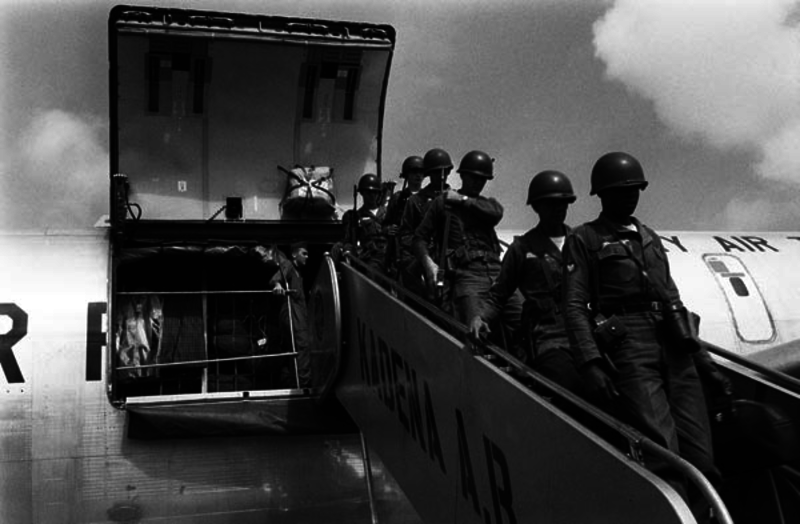 |
| Kadena Air Base, early 1960s. | US soldiers en route to Vietnam arriving from Hawaii at Kadena, February 1962. |
Kadena Air Base served as the Pentagon’s key transport hub. During the war, it racked up one million flights making it one of the busiest airports on the planet; starting in 1968, B-52’s also took off from the base to bomb Southeast Asia. In Okinawa’s capital, Naha Port processed 75% of all supplies for the conflict – including fuel, food and ammunition. Moreover, the port handled surplus and damaged materiel from the war zone. A section of nearby Makiminato Service Area, for example, earned the nickname “The Bone Yard”, due to its piles of jeeps and trucks – many covered in blood and bullet holes – which had arrived for repair from Vietnam.5 So vital was the island for the Pentagon that, in 1965, the Commander of U.S. Pacific Forces declared, “Without Okinawa, we couldn’t continue fighting the Vietnam war.”6
The Pentagon’s war machine required a massive workforce; during the Vietnam War, approximately 50,000 Okinawans were employed by the U.S. military.7
|
Kichi de hataraku (Working on the bases). |
In 2013, The Okinawa Times published a book titled Kichi de hataraku (Working on the bases) in which it compiled interviews with 83 of these former workers. What comes across most poignantly in many of these accounts is how deeply embedded Okinawans were in the war effort. At ammunition depots, they packed explosives and processed faulty munitions; at Makiminato, they helped to print Vietnamese propaganda flyers for the U.S. Army’s 7th Psychological Operations Group. In the Northern Training Area (NTA), Okinawans were hired for a dollar a day to act the enemy in war games played out in mock Vietnamese villages. Okinawans were also sent to South Vietnam to drive buses within U.S. bases; others worked – and were killed – aboard American ships transporting supplies in the waters of Vietnam.8
Due to Okinawa’s gray-zone status, base workers tasked with hazardous tasks were not safeguarded by American or Japanese labour regulations. These employees handled toxic chemicals without special training, protective equipment or warnings of the dangers. As a result, hundreds fell ill from exposure to substances including insecticides, hexavalent chromium and asbestos.9
During the Vietnam War, Okinawa’s economic situation was bleak so many residents appreciated base jobs, which were relatively stable and well-paid. Yet for many Okinawans, such labour was accompanied by a sense of complicity in the deaths of hundreds of thousands of Southeast Asians. This distress was magnified by memories of the spring 1945 Battle of Okinawa in which almost one third of the island’s civilian population had been slaughtered.
|
Koza, Okinawa, 1970. |
No one better captures Okinawans’ complex emotions to the Vietnam War than photographer Ishikawa Bunyo. Born in Naha in 1938, Ishikawa photographed the war between 1965 and 1968 – and today his images of the conflict are some of the most famous in Japan.10
Sheltering from a fire-fight, an American adviser talks into a radio through his bloodied mouth. Young GI’s surround an enemy prisoner – looking as scared and confused as their captive. A soldier with an M-60 machine gun lies in a field of grass reading a book – a rare moment of tranquility in the chaos of combat. Ishikawa’s affinity with his subjects comes across in many of his images of young Americans.
“Because these U.S. soldiers had been stationed on Okinawa, I felt a connection with them. In Vietnam, we used to talk about Okinawa’s neighbourhoods and the bars where we drank. We had a lot in common,” explains Ishikawa. 11
|
Ishikawa Bunyo |
So strong was Ishikawa’s feelings for the GI’s that, after the war, he traveled to the Vietnam War Memorial in Washington to search for the names of those he’d photographed among the granite lists of the dead.
During the war, many Okinawans shared Ishikawa’s compassion towards U.S. troops. Despite residents’ anger with the Pentagon for burdening their island with so many bases, many people befriended – and married – service members. In particular, there was solidarity for those who had been involuntarily-conscripted and African-Americans who, many Okinawans felt, suffered discrimination from the U.S. authorities which mirrored their own.
Equally powerful as Ishikawa’s images of combat in Vietnam are those which he took on Okinawa during the war. He photographed the shot-up trucks returned via Naha Port, war games in the NTA and fresh recruits preparing to go to Vietnam.
“Seeing U.S. troops heading to the war gave me very complicated feelings. On one hand, I didn’t want them to go and kill Vietnamese people but at the same time, I wanted them to come back safely to Okinawa,” Ishikawa says. However, when some of these soldiers did return to Okinawa, they brought the violence of the war back with them.
One of Ishikawa’s most powerful images is called Otto ga korosareta (My husband was killed), which shows the widow of a taxi driver murdered by a GI in October 1971.
Between 1965 and 1975, at least 17 Okinawans were killed by Americans – and many more were robbed, raped or assaulted. Most at risk were those whose work brought them into daily contact with U.S. service members – including maids, taxi drivers and bar workers.12
As well as such violence, Okinawans bore the brunt of military accidents – including hit-and-run auto accidnets and aircraft crashes. For instance, in June 1965, a trailer dropped by parachute from a plane over Yomitan crushed an 11-year old girl to death and in November 1967, a 4-year old girl was run over and killed by a military crane.
During the Vietnam War, many Okinawans threw their support behind the reversion movement which sought to return their island to Japanese rule of law. Especially, they hoped that Japan’s peace constitution would reduce the number of U.S. bases on Okinawa and curtail their usage for the conflict in Southeast Asia.
|
Protest against US base, before Kadena Air Base, March 1971. |
On mainland Japan – as on Okinawa – the majority of people were against the war. Surveys revealed overwhelming opposition to the conflict and, in the late 1960s, millions of mainlanders participated in demonstrations to express their anger at the war. Beheiren (Japan Peace for Vietnam Committee), the umbrella movement of loosely-affiliated anti-war groups, included such well-known luminaries as artist Okamoto Taro and novelist Oe Kenzaburo, who today remains active in the anti-nuclear movement. 13
Douglas Lummis, a former U.S. marine, became involved in the anti-war movement in Tokyo in the late 1960s. According to Lummis, what won Beheiren most attention was the help it afforded U.S. deserters. 14
“Beheiren used to hand out flyers near the U.S. bases around Tokyo and Kanagawa encouraging GIs to desert. The first four deserters that Beheiren handled… were at first hidden in a love hotel – one of the few places the police couldn’t search.”
According to Lummis, Beheiren put the deserters on the “underground railroad” – first traveling by ferry to Hokkaido and then across to the USSR and eventually to Sweden. However, after being infiltrated, they began hiding the Americans in Japanese people’s homes.”
In 1971, Lummis traveled to Okinawa where he helped to interpret during meetings between members of the Okinawan base worker unions and GI black power groups. “The war crystallized many people’s feelings against the United States,” explains Lummis.
Although the majority of mainland Japanese opposed the war, unlike on Okinawa, the conflict did not directly affect their lives. As political scientist Royama Michio explained in his famous analogy, “Vietnam was a big fire, but it was a fire on the other side of the river.”15
|
Richard Nixon and Sato Eisaku, 1972. |
In contrast, the Japanese government tacitly backed the war – in 1965 PM Sato Eisaku declared his “moral support” for the conflict – and Japanese corporations, who provided base-building materials and supplies for U.S. troops, pocketed around $1 billion a year from the fighting.16
Against this backdrop, as the Vietnam War raged from the ‘60s into the ‘70s, the Japanese government entered into negotiations with the U.S. for the return of Okinawa. At the time, Tokyo pledged to island residents that reversion would take place under hondo nami – i.e. the number of U.S. bases on Okinawa would be reduced to a similar level as the mainland.17
Okinawa finally reverted to Japanese control on May 15 1972. But Okinawans soon realized the promise had been broken.
“Although reversion looked like a favour by the U.S., actually it was a great deal for the Pentagon – it could keep using the bases without needing to pay for them,” says Sato Manabu, professor of political science at Okinawa International University. “From then on, Japanese taxpayers footed the bill while the U.S. could continue to use them for the war with impunity.”
Today, many Okinawans still feel they are suffering the consequences of that Vietnam War era betrayal. The island still hosts more than half of U.S. forces in Japan but their economic contribution to the island has plummeted from more than 20% during the war to less than 5%, according to official prefectural estimates. While curfews and cultural awareness training have dramatically reduced the number of military crimes committed against residents (for example 2014 saw a record low of reported crimes),18 last year Okinawans were given a frightening reminder of the Vietnam War when barrels containing suspected military defoliants were uncovered from land which had previously been part of Kadena Air Base.19
These ongoing problems might explain why the Pentagon’s website to commemorate the 50th anniversary of the Vietnam War – vietnamwar50th.com – contains zero references to Okinawa. Likewise a request for comment from USMC on Okinawa resulted in a stock response which made no mention of the island. 20
Such reluctance to recognise the role of Okinawa in the Vietnam war is best understood by a visit to two of the installations central to Pentagon war efforts: the Northern Training Area (NTA), where Okinawans were paid a dollar a day for war games, and Camp Schwab, former storage site for nuclear warheads and, according to many seriously-ill U.S. veterans, Agent Orange.21
Despite overwhelming public opposition, today there are plans to expand both bases.
Alongside the NTA, for the past eight years, local residents have been demonstrating against the construction of Pentagon helipads which, they argue, threaten the safety of their community. Meanwhile near Camp Schwab, Okinawans have been engaged in an 18-year struggle against a new U.S. base. This base plan was conceived by Washington in the mid-1960s, but later it was shelved due to the cost; now it has been resurrected as a mega-base replete with twin 1800m runways and a deep-sea port – all built atop one of Japan’s sole-surviving coral reefs.22
|
Camp Schwab |
Unlike the previous bases used in the Vietnam War, these new projects are being constructed by Tokyo with Japanese tax money; further proof, according to many Okinawans, that the hondo nami promise of reversion was indeed betrayed.
Today many of those opposing the new bases can recall firsthand how Okinawa was used during the Vietnam War – and they vow not to let their island be exploited in such a way again.
One of these is Shimabukuro Fumiko – one of the participants in the current sit-in outside Camp Schwab. During the 1960s, Shimabukuro worked as a maid on the installation – but the Pentagon’s aggression in Southeast Asia filled her with such a sense of complicity that she quit.
Photographer Ishikawa is an equally adamant opponent of the planned installation.
“If the new base is built, it will be used for future wars. Nothing has really changed since the Vietnam War – Okinawa is still being used by the U.S. military,” says Ishikawa.
Former Marine Lummis, now a resident of Okinawa, believes it is vital now more than ever to remember the lessons of the war.
“Today many young people don’t know there even was a war in Vietnam – and those that do remember haven’t grasped that the U.S. lost that war – and almost every war since. The Japanese government insists that Japan should stick with the U.S. for its defense – but we need to rethink what power really is.”
“Ishikawa Bunyo Photography Exhibit ‘The Vietnam War and Okinawa’s Bases,’” Okinawa Times (in Japanese).
* * *
This is a revised and expanded article which originally appeared in The Japan Times on March 7 under the title, “Battle scars: Okinawa and the Vietnam War”.
Welsh journalist, Jon Mitchell, is the author of Tsuiseki: Okinawa no Karehazai (Chasing Agent Orange on Okinawa) (Koubunken 2014) and a visiting researcher at the International Peace Research Institute of Meiji Gakuin University, Tokyo. Mitchell is an Asia-Pacific Journal contributing editor.
Related Articles
Jon Mitchell, “Military Contamination on Okinawa: PCBs and Agent Orange at Kadena Air Base”
Jon Mitchell, “Okinawa – The Pentagon’s Toxic Junk Heap of the Pacific”
Gavan McCormack, “‘All Japan’ versus ‘All Okinawa’ – Abe Shinzo’s Military-Firstism”
Linda Hoaglund, “Protest Art in 1950s Japan: The Forgotten Reportage Painters”
Recommended citation: Jon Mitchell, “Vietnam: Okinawa’s Forgotten War”, The Asia-Pacific Journal, Vol. 13, Issue 15, No. 1, April 20, 2015.
Notes
1. One of the best primers on the U.S. involvement in Vietnam is Nick Turse, Kill Anything that Moves, (New York : Metropolitan Books 2013)
2. Quoted in Thomas R. H. Havens, Fire Across the Sea: The Vietnam War and Japan 1965-1975 (Princeton: Princeton University Press, 1987), 193.
3. Some of the best discussions (in English) of Okinawa’s 1945~1972 period appear in Gavan McCormack and Satoko Norimatsu, Resistant Islands: Okinawa Confronts Japan and the United States (Lanham, MD: Rowman and Littlefield Publishers Inc. 2012)
4. See, for example, Jon Mitchell, Tsuiseki: Okinawa no Karehazai (Tokyo: Koubunken, 2014)
5. Ibid., 60
6. Quoted in Havens, 85.
7. Okinawa Times, Kichi de Hataraku: Gunsagyouin no Sengo (Naha, Okinawa: Okinawa Times Co, 2013)
8. Ibid., Chapter 2.
9. Ibid., 262-3.
10. Sadly, there are no English versions of Ishikawa’s work. However, some of his most iconic images appear in Ishikawa Bunyo, Okinawa: Waga Furusato (Tokyo: Look Publishing, 1998) and Ishikawa Bunyo, Okinawa: Betonamu Houdou 35 Nen (Tokyo: Look Publishing, 1998)
11. From interview with author conducted on 28 January 2015.
12. For a comprehensive, English list of U.S.-military crimes and accidents (1948 ~ 19995), see here: http://www.uchinanchu.org/history/list_of_crimes.html
The list was originally compiled by The Okinawa Times.
13. Havens, 54-7.
14. From interview with author conducted on 30 January 2015.
15. Quoted in Havens, 52.
16. Ibid., 96
17. Miyume Tanji, Myth, Protest and Struggle in Okinawa (Oxon: Routledge, 2006), 109.
18. Stars and Stripes, “Number of SOFA Personnel Accused of Crimes on Okinawa Drops” March 3, 2015 Available here.
19. See Jon Mitchell, “Okinawa Dumpsite Offers Proof of Agent Orange: Experts Say,” The Asia-Pacific Journal, Vol. 11, Issue 38, No. 1, September 23, 2013. Available here.
20. February 3 email from Michael Ard, Director, MCIPAC Public Affairs Office. Ard did not respond to a further request for comment on February 23.
21. See for example the 2012 documentary about Agent Orange on Okinawa, “Defoliated Island” (Ryukyu Asahi Housou) available here.
22. See McCormack and Norimatsu 91~113




